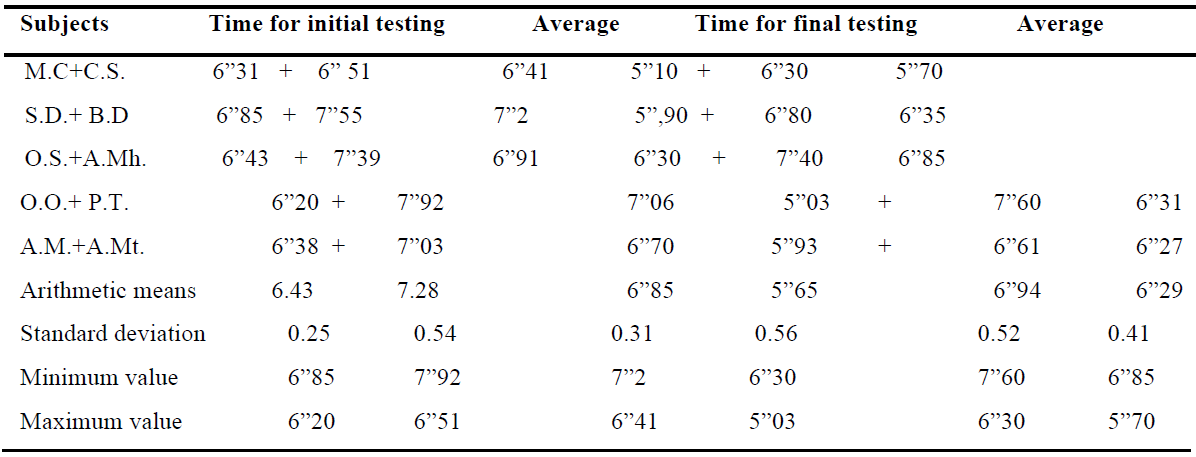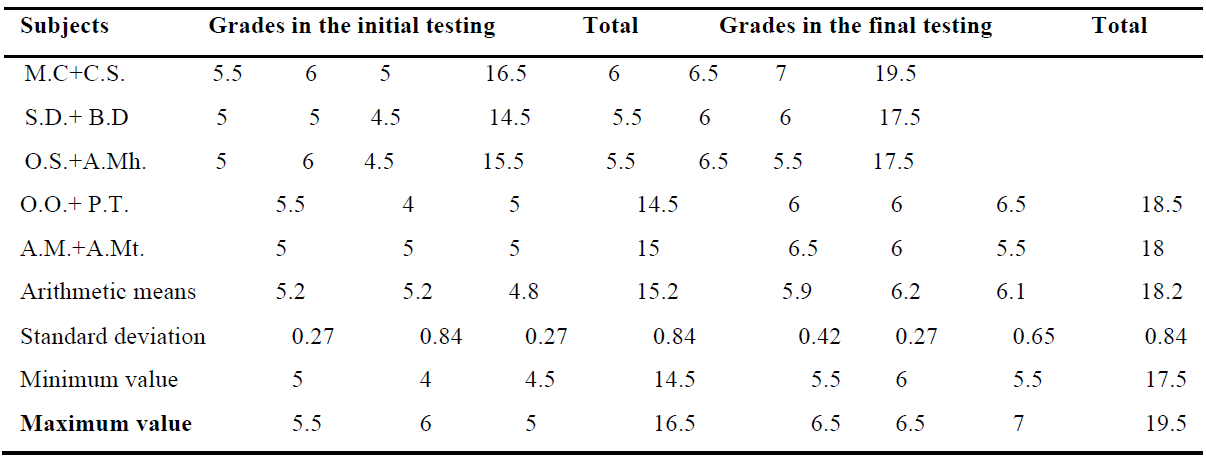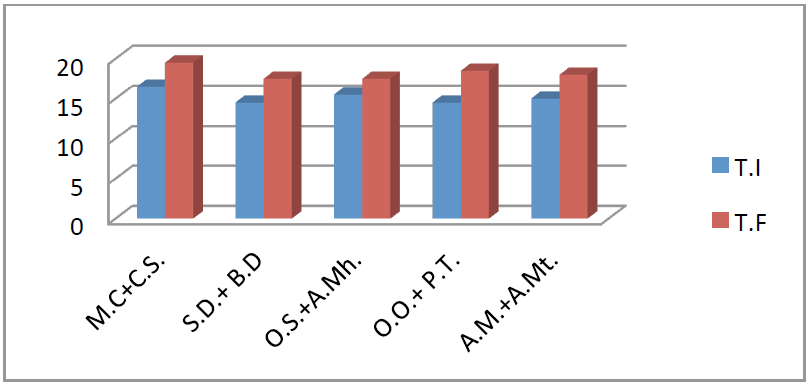Abstract
Developing the technical level of aspiring athletes in Duo-demonstrative system represents a permanent requirement in competitional ju-jitsu. This paper represents an experimental study of ascertaining type through which we aimed to highlight the possibility of improving the technical level of competing athletes in duo-demonstration system. To establish the progress of the technical level we applied an initial test with an ascertaining character and a final test with a demonstrative character. In order to improve the athletes' technical level during the 14-week experiment that included 4 specific trainings per week, we added 30 minutes to each training using the following methods: Monday- slow work method and technique segmentation method; Tuesday- working with the shadow and working in special conditions methods; Thursday-countertime method and remote working method; Friday- we approached the method of techniques execution using unconventional means. The results of the 10 subjects of the experiment showed higher rates at the final test. The progress showed by the average values emphasizes the efficiency of the applicative intervention directed towards improvement of the technical level. The results revealed that, after the 14 weeks experiment, the level of the subjects' technical training has improved considerably.
Keywords: Ju-jitsu; technique; methodsduo-demonstration system
Introduction
Ju-jitsu is considered the source of Japanese martial arts, including the two most representative
modern arts, Judo – "the way of grace”, sportive martial arts and Aikido – "the way of harmony" martial art where no competitive activity is organized, as its founder desired. Virtually, Ju-jitsu continued to exist
shadowed by the two disciplines, until, invalidating the opinions of skeptics according to whom ju-jitsu
cannot have a [sportive] competitive system, a sportive side of it was created, the Duo-demonstrative
system respectively, which is growing constantly, indicating the special virtues of this martial style, and
the Fighting system.
Virtually, by this competitive system the specific technique is indicated as close from the real
conditions, by highly appealing the physical and psychical system in an attempt to represent a possible
confrontation, which, however, it snot aimed to destroy the opponent, but to show the sportive mastery
implementing the "ju" principle - of "grace", with a minimum of effort in order to obtain maximum of
efficiency (Gurski, 1995).
The ingenuity spontaneity, creativity, the display of motric skills and high coordinative capacities
etc., are only a few of the aspects that are displayed at the age of 12-15 or even in younger children, both
in the Fighting system and especially in the Duo-demonstrative system. As a matter of fact, this
competitive system reproduces at its best the true display of the old martial arts virtues - bugei, displaying
the warrior spirit of the legendars bushi, the legendary warriors of medieval Japan (Oscar & Westbrook,
1999).The provisions of the competitive regulation of IJJF (International Ju-jitsu Federation), clearly
stipulates that, in order to obtain a higher mark, a pair of athletes evolving in the duo-demonstrative
system have to fulfill certain mandatory criteria such as:
realism, i.e. the technique presented has to display the conditions as close as possible of a real
possible fight;
the power of attack, i.e. the attacks placed with force, directed on the well-defined areas of the
competition partner body;
control: no technique employed, both related to attack or the "defense" has to endanger the
bodily integrity of the competition partner. Nevertheless, if it still happens, the respective pair is
sanctioned, receiving a lower mark or being disqualified from the competition.
speed, it is virtually the criterion strengthening all those above. The execution of attack, of the
defense at speed, respectively, confers an impression of realism of the demonstrative program;
the attitude signifies the idea of dignity specific to samurai who, regardless of their current state
(sickness, accident, injury, lost of someone dear, etc.) had to be estimable, austere, even distant "from
life" (Nitobe, 1995);
variety, i.e. the techniques demonstrated had to reflect the exceptional diversity of Ju-jitsu
(hitting techniques,. including the sensitive points, projection, articulation, strangling, attacking the
sensitive points of human body, of using / defending the traditional weapons etc);
efficiency, it is indicated in the way the other criteria are being complied with (control, power of
attack, realism), but also in he way the techniques are being executed, a criterion that related to the way
the demonstration is conceived and by the compliance of correct execution of techniques in terms of bio-
mechanical and technical matters.
The display of the criteria listed above, involves complex motric skills and capacities, partially
automatized, coming from elementary habits and from non-automatic movements or incompletely
automatized but which, however, tend to be automatized, so that, at least the combatant that performs the
defense technique may work with his eyes closed, showing perfect technical executions, efficiency, control, motric memory, grace and expressiveness and an effort specific to this competitive system
(Deliu, 2002).
Hypothesis, Objectives and Tasks of Research
Our scientific approach came from the wording of the following hypothesis:
Therefore, our research program is aimed to assess the evolution of the approach and presentation
in a competition of the demonstrative programs of the trainees involved in the competition, selected from
a quite large number of trainees.
The main objective of this research was the effects assessment of changing the approach of
specific training, introducing certain original training methods - lots of them being the product of
personal experience I gained in this area, methods that were aimed to complete the classical repetition of
the demonstrative programs, or even to replace certain training methods which we consider inadequate
for a modern training.
The tasks in conducting the research concerned: setting the research theme, the scope of research,
tasks, hypothesis, methods, the research sample, the assessment data of testing and the assessment
indicators, the applicative interventions in line with the hypothesis, as well as the implementation of the
assessment tests, collection, processing and interpretation of data, indicating the progress and preparing
the appropriate conclusions.
Materials and Methods
Within the experimental research I have involved 10 people (5 female subjects and 5 male
subjects) aged 12-15 (cadets) building 5 teams participating in the mixed demonstrative duo in the
Martial Arts Club Budo Seishin Bucharest. The experiment was commenced on February 28, 2015 with
the initial testing and was completed on June 7, 2015 with the final testing. The respective testing
included: the test "in square" (Dragnea, 1984) and participation to a verification cup, where each team
presented its demonstrative program where I selected the best score of each team.
In conducting the study I used the following research methods: the bibliographic study; the
pedagogical observation experiment; testing, the statistic and mathematical method; the graphical method
(R. Thomas, Jack K. N., 1996). In order to be able to see the evolution of my subjects I used the test "in
square" (where I calculated the arithmetic mean for each team) and testing under real-competition
conditions participating in two verification cups (one for the initial testing on June 7, 2015 and another
one for the final testing on February 28, 2015) where the best score within the evolutions into the
competition of each team was selected. The statistical computational indexes were as follows: the
arithmetic mean (X); standard deviation (S); maximum value (V max) and minimum value (V. min.).
The experiment lasted for 14 weeks, including 4 specific training of one hour a week, adding 30
minutes for using certain methods to improve the athletes' training level. In completion of the usual
training, I introduced these methods as follows:
- Monday: the method of working in slow motion, characterized by performing all movements in
slow motion, expressively and real, aiming to observe all the execution details and learning correctly the
specific technique, with a double role: of learning the content of the technical features of the procedures,
respectively, awareness and understanding the sense of techniques' content;
- Monday: the technique segmentation method: I used it especially to improve certain parts,
especially within complex techniques;
- Tuesday: the method of working in the shadow, which is also known as the shadow boxing
(Deliu, 2008), to facilitate the individual study in the absence of a partner. Virtually, by this method we
have in mind a more precise execution of the technical elements performed without a partner, but
observing all the execution states and the distinctive elements of the techniques that compound the
demonstrative programs;
- Tuesday: the method of working under special conditions, involved the fact that
should execute the techniques with additional equipment (vests with weights, sacks with sand attached to
arms and/or legs, helmets) or on different working surfaces, without specific equipment; after the
execution of two or three repetitions, the "difficult conditions" are eliminated and two another repetitions
are executed under normal conditions to see the difference in execution;
- Thursday: working conditions out of step: involves the exercise of techniques under maximum
speed, within the shortest time possible, in order to develop the execution speed, the specific resistance
and habitualness of working under stress;
- Thursday: the method of distant working: it means that uke and tori have to execute their
techniques without having a contact; this type of practice helps them to coordinate and develop their
expressiveness, sense of rhythm, coordination with partner;
- Friday: the method of executing the techniques with non-conventional means (Galan, 2005): it
involves the execution of techniques under the following way: tori is tied up with a scarf, uke has his eyes
uncovered; this method is aimed at strengthening the connection between partners, to feel the techniques
in an appropriate manner, to develop balance, of spatial and temporal orientation, the sense of rhythm, of
direction of attack, of the area and the response mode etc.
Results Obtained and Their Assessment
After recording the initial and final results of testing, we proceeded to processing and analyzing
thereof. In construing the data, we relied on the assessment of arithmetic means value, of standard
deviation and minimum and maximum values. The processing of data and their assessment allow us to
show the progressive dynamics of results. In table no. 1 we showed the results of the "square" test, and in
table no. 2, the results of the two verification competitions.


After collecting all the data, we can indicate the following results:
- subjects M.C.+C.S., within T.I. for the "square" test, had the average grade of 6”41, and for the final
test they had 5”70, registering a modest progress of only 0.71 milliseconds compared to their initial time.
During the competition, the T.I value was of 16.5, and the T.F value was of 19.5; therefore, during this
test we were able to see a progress of 3 points;
- subjects S.D.+B.D., within T.I. for the "square" test, had the average grade of 7”2, and for the final
test they had 6”35, registering a modest progress of 0.85 milliseconds compared to their initial time.
During the competition, the T.I value was of 14.5, and the T.F value was of 17.5; therefore, during this
test we were able to see a progress of 3 points;
- subjects O.S.+A.Mh, within T.I. for the "square" test, had the average grade of 6”91, and for the final
test they had 6”85, registering a modest progress of 0.06 milliseconds compared to their initial time.
During the competition, the T.I value was of 15.5, and the T.F value was of 17.5; therefore, during this
test we were able to see a progress of 2 points;
- subjects O.O+P.T., within T.I. for the "square" test, had the average grade of 7”06, and for the final
test they had 6”31, registering a modest progress of 0.24 milliseconds compared to their initial time.
During the competition, the T.I value was of 14.5, and the T.F value was of 18.5; therefore, during this
test we were able to see a progress of 4 points;
- subjects A.M.+A.Mt, within T.I. for the "square" test, had the average grade of 6”70, and for the
final test they had 6”27, registering a modest progress of 0.75 milliseconds compared to their initial time.
During the competition, the T.I value was of 15, and the T.F value was of 18; therefore, during this test
we were able to see a progress of 3 points;

Conclusions
Data recorded during the research indicated pertinent progresses and conclusions. We consider
that, following the researches, we obtained essential information concerning the methods employed, as it
fulfilled its tasks proposed during the planning stage, having a decisive contribution in improving the
final results.
Therefore, following the analysis of results, we can clearly see that during the first verification, in
the "square" test V. max. was of 6”41 milliseconds, V. min. was of 7”02, and the arithmetic means was of
6”85 milliseconds. During the second testing we see that V. max. was of 5”70, V. min. of 6”85, and the
arithmetic means of the second testing for the "square" test was improved by 0”56 milliseconds,
amounting to 6”29 milliseconds. During the "competition" test, in the initial testing V. max. was of 16,5,
V. min. was of 14,5, and the arithmetic means was of 15.2. In the final testing we had V. max. of 19.5, V.
min. of 17.5 and an average grade of 18.2, indicating an increase of 3 points.
After conducting this test, we are able to consider that the hypothesis according to which "
- studying the specialized literature we can see that the research subject proposed is not addressed; the
interest for the update and modernizing the practicing methods in competitive ju-jitsu is a must in order to
improve the sportive results in this style;
- knowing the factors of practicing in developing the strategies is the key element in accessing the
future methods used during the practice to obtain high performance;
- constantly involving into the practice the physical factor helps the athletes to prove their self-control
and increase command in accomplishing the motric tasks;
- the application of proposed methods has lead to raising awareness and high involvement of athletes
during the training, passing automatically from mechanic repetition to the logic and assumed repetition;
- a considerable improvement was seen in terms of criteria, the power of attack, control, realism,
attitude and speed, and we consider that these elements had a contribution in better grades awarded by
arbiters.
- the use of individual methods must be made by respecting every step already existing in the
programme;
- each time there are identified mistakes in the specific training of this system, it is recommended an
intervention with the method of working in slow motion and the method of working in the shadow;
-when it is observed a lack of speed in the execution of the techniques, it is recommended an extended
use of working conditions out of step and the method of working under special conditions.
We consider that this survey opened the road to new studies and it can help to increase the sportive
results in the duo-demonstrative system.
References
- Deliu, D. (2002). Cursuri teoretico-metodice de arte marţiale. Bucureşti, Editura Studenţească.
- Deliu, D. (2008). Antrenamentul sportiv în disciplinele sportive de combat. București, Editura Bern. Dragnea, A. (1984). Măsurare și evaluare în educație fizică. București, Editura Sport-Turism.
- Galan, D. (2005). JU-JITSU: elemente de teorie, filozofie şi metodică de antrenament. Bucureşti, Editura
- Estfallia.
- Gurski, A. (1995). JIU JITSU, kihon & kata. Bucureşti, Garell Publishing House.
- Nitobe, I. (1995). BUSHIDO – calea samuraiului. Bucureşti, Editura Garell Publishing House.
- Oscar, R., Westbrook, A. (1999). Secret of the Martial Arts of Feudal Japan. Boston – USA, Castle Books a division of Book Sales, Inc. Edison.
- Thomas, R., Jack, K. N. (1996). Metodologia cercetării corporale în activitatea fizică. Bucureşti, M.T.S. / C.C.P.P.S.
Copyright information

This work is licensed under a Creative Commons Attribution-NonCommercial-NoDerivatives 4.0 International License.
About this article
Publication Date
25 May 2017
Article Doi
eBook ISBN
978-1-80296-022-8
Publisher
Future Academy
Volume
23
Print ISBN (optional)
-
Edition Number
1st Edition
Pages
1-2032
Subjects
Educational strategies, educational policy, organization of education, management of education, teacher, teacher training
Cite this article as:
Galan, D. P., Rață, G., & Galan, D. D. (2017). Study On Improving The Technical Level Of Athletes Practicing Ju-Jitsu. In E. Soare, & C. Langa (Eds.), Education Facing Contemporary World Issues, vol 23. European Proceedings of Social and Behavioural Sciences (pp. 876-882). Future Academy. https://doi.org/10.15405/epsbs.2017.05.02.107

